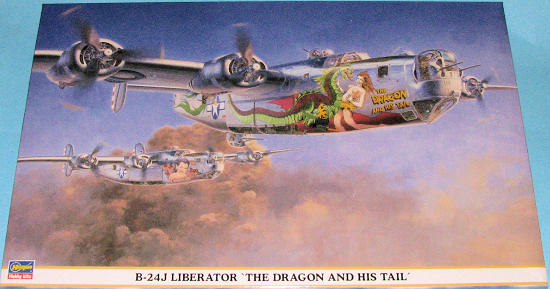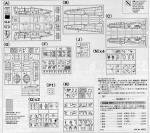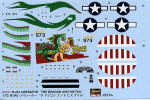
| KIT #: | 00947 |
| PRICE: | $87.00 MSRP |
| DECALS: | One option |
| REVIEWER: | Scott Van Aken |
| NOTES: | Limited release |

| HISTORY |
The 43rd Bomb Group
Constituted as 43rd Bombardment Group (Heavy) on 20 Nov 1940. Activated on 15 Jan 1941. Trained with B-17, B-18, A-29, and LB-30 aircraft. Flew some antisubmarine patrols along the New England coast, Dec 1941-Feb 1942.
Moved to the Southwest Pacific, via Capetown, Feb-Mar 1942. Became part of Fifth AF. Equipped first with B-17's, but converted to B-24's, May-Sep 1943. Operated from Australia, New Guinea, and Owi Island, Aug 1941-Nov 1944, making numerous attacks on Japanese shipping in the Netherlands East Indies and the Bismarck Archipelago. Experimented with skip bombing and used this method for some shipping strikes, including attacks on Japanese vessels during the Battle of the Bismarck Sea, 2-4 Mar 1943; received a DUC for participation in this latter action in which repeated air attacks destroyed a large enemy convoy carrying reinforcements to New Guinea. Other operations during this period included support for ground forces on New Guinea; attacks on airfields and installations in New Guinea, the Bismarck Archipelago, Celebes, Halmahera, Yap, Palau, and the southern Philippines; and long-range raids against oil refineries on Ceram and Borneo. Capt Jay Zeamer Jr, pilot, and 2nd Lt Joseph R Sarnoski, bombardier, each won the Medal of Honor for action during a photographic mapping mission over the Solomon Islands on 16 Jun 1943: when the mission was nearly completed, their aircraft was assaulted by about 20 interceptors; although painfully wounded, Lt Sarnoski remained at the nose guns and fired at the enemy until he died at his post; sustaining severe injuries, Capt Zeamer maneuvered the plane until the enemy had broken combat, then directed the flight to a base more than 500 miles away. After moving to the Philippines in Nov 1944, the group attacked shipping along the Asiatic coast; struck industries, airfields, and installations in China and Formosa; and supported ground forces on Luzon. Moved to Ie Shima in Jul 1945 and conducted missions against airfields and railways in Japan and against shipping in the Inland Sea and the Sea of Japan. Returned to the Philippines in in Dec 1945. Inactivated on 29 Apr 1946.
Redesignated 43rd Bombardment Group (Very Heavy). Activated in the US on 1 Oct 1946. Assigned to Strategic Air Command. Redesignated 43rd Bombardment Group (Medium) in Jul 1948. Equipped first with B-29's, then with B-50's. Trained and conducted long-range test missions, including the first nonstop flight around the world (26 Feb-2 Mar 1949), accomplished in "Lucky Lady II," a B-50 commanded by Capt James G Gallagher. Inactivated on 16 Jun 1952.
Squadrons. 63d: 1941-1946; 1946-1952. 64th: 1941-1946; 1946-1952. 65th: 1941-1946; 1946-1952. 403d: 1942-1946.
Stations. Langley Field, Va, 15 Jan 1941; Bangor, Maine, 28 Aug 1941-17 Feb 1942; Sydney, Australia, 28 Mar 1942; Torrens Creek, Australia, c. 1 Aug 1942; Port Moresby, New Guinea, 14 Sep 1942; Dobodura, New Guinea, 10 Dec 1943; Nadzab, New Guinea, 4 Mar 1944; Owi, Schouten Islands, 2 Jul 1944; Tacloban, Leyte, c. 15 Nov 1944; Clark Field, Luzon, 16 Mar 1945; Ie Shima, 26 Jul 1945; Ft William McKinley, Luzon, 10 Dec 1945-29 Apr 1946. Davis-Monthan Field, Ariz, 1 Oct 1946 - 16 Jun 1952.
Commanders. Lt Col Harold D Smith, 15 Jan 1941; Lt Col Francis B Valentine, 1 Mar 1941; Maj Conrad H Diehl Jr, 18 Feb 1942; Col Roger M Ramey, 21 Oct 1942; Lt Col John A Roberts, 30 Mar 1943; Col Harry Hawthorne, 24 May 1943; Lt Col Edward W Scott Jr, 18 Nov 1943; Col Harry Hawthorne, 8 Feb 1944; Col James T Pettus Jr, 18 Sep 1944; Maj Paul B Hansen, 8 Sep 1945-unkn. Col James C Selser Jr, 5 Oct 1946; Col William E Eubank Jr, Apr 1948; Col Dalene Bailey, Jul 1948; Col Alvan N Moore, 3 Jan 1949-16 Jun 1952.
Campaigns. Antisubmarine, American Theater; Air Offensive, Japan; China Defensive; Papua; New Guinea; Bismarck Archipelago; Western Pacific; Leyte; Luzon; Southern Philippines; Ryukyus; China Offensive.
Decorations. Distinguished Unit Citations: Papua, [Aug] 1942-23 Jan 1943; Bismarck Sea, 2-4 Mar 1943. Philippine Presidential Unit Citation.
Insigne. Shield: Per fess nebuly or and azure, a drop bomb counterchanged. Motto: Willing, Able, Ready. (Approved 31 Jan 1942.)
In the last year of the war, the 43rd had some of the most extensive and exotic nose art ever carried by American warplanes. Fortunately, much of it was extensively photographed.
This official history only goes to 1952. They subsequently returned to the USAF roster with B-47s and later, B-58s. When the B-58s went away it was deactivated until reactivating with B-52s out of Guam. It was then deactivated and renewed twice more, once as a KC-135 equipped refueling wing and now it is a C-130 unit flying out of Pope AFB.
| THE KIT |
 This
is your standard Hasegawa B-24J with a new decal sheet. In fact, the only
difference in what is used from the sprues is the elimination of the 'U' shaped
nose antenna and this one uses the bulged side cockpit windows. Just for a
refresher, here is what the kit is like:
This
is your standard Hasegawa B-24J with a new decal sheet. In fact, the only
difference in what is used from the sprues is the elimination of the 'U' shaped
nose antenna and this one uses the bulged side cockpit windows. Just for a
refresher, here is what the kit is like:
The kit itself is almost identical to the B-24D version aside from the new clear nose section. Though many B-24Ds were retrofitted with tail turrets in the nose, the H and later J models had a number of different turrets used depending on who made the planes as much as anything else. Anyway, the kit has the usual superbly done panel lines, a few ejector pin marks to deal with and what seems to be a nicely engineered kit as one can install all the turrets after the airframe is completed.
Options include a stowed or open ball turret, an A-15 or A-6A nose turret, and the ability to pose the bomb bay doors open or closed. Optional cockpit side windows are also given with one set having tear drop sections molded in place. The kit includes a fully detailed bomb bay and a very nicely done cockpit (decals for instruments, of course). There is also detail in the gunner's section. Hasegawa provides a stub wing spar to help mount those long wings and keep them from drooping while the cement dries.
 seams on the blisters.
seams on the blisters.| CONCLUSIONS |
The subject of this kit is probably the most sought after markings that are around. I anticipate this one being sold out in somewhat short order.
As another note, this aircraft undoubtedly flew without the ball turret. SWPA B-24s frequently removed it, replacing it with twin 50s on a ring mount. A clear plexiglas dome on the inside, attached to the old ball turret mount, prevented folks from falling out. Just aft of the mount, a pair of additional rectangular windows was placed on both sides of the fuselage to aid the gunner in seeing outside the aircraft. The guns were manually trained and elevated.
| REFERENCES |
http://www.globalsecurity.org/
April 2009 Thanks to
www.dragonmodelsusa.com
for the preview kit. Get yours today at your local shop or on-line store.
If you would like your product reviewed fairly and quickly, please
contact
me or see other details in the
Note to
Contributors.